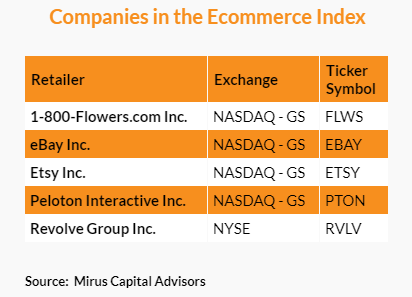
Stuart Rose, partner, Mirus Capital Advisors
COVID-19 is the story of the year 2020. It had a profound effect on our businesses, politics, health and relationships.
Analyzing the effects on relationships, politics and health should be left to doctors, therapists and pundits. How it affected business, especially ecommerce, is fascinating.
While much of the country shut down beginning in mid-March—including most retail—much of ecommerce thrived. Buying remotely became the only way to purchase many categories. Amazon, FedEx and UPS could hardly keep up. Second-quarter 2020 saw a 31.9% increase in ecommerce sales from the first quarter of 2020.
U.S. Census Bureau data show ecommerce, as a percentage of all retail sales, rose from 11.8% in the first quarter of 2020 to 16.1% in the second quarter. There is a lot of noise in those numbers, such as the long-term trend towards ecommerce, declining retail sales in the short term and two weeks of lockdown in the first quarter. Comparing third quarter 2019 to third-quarter 2020 will give a clearer picture. Here we see an increase in ecommerce as a percent of retail sales from 11.2% to 14.3%—an acceleration from the long-term trend.
But the real question clients and prospects want to answer is whether the COVID-19 Bump has affected valuations. Will buyers discount valuations presuming that earnings will return to pre-COVID levels? Retailers of all stripes are looking at the COVID Bump—an acceleration of ongoing trends. With the continued strong sales trends in ecommerce and catalog retailers generally, the current view among consumer industry executives—including the CEOs of Wayfair, Macy’s and 1-800 Flowers—is that ongoing shifts in consumer purchasing trends have accelerated and compressed several years of change into 2020. We have reached a new normal.

The shift toward ecommerce and increased earnings have increased ecommerce valuations in the public market, but, surprisingly, not that much more than the overall market. The charts below show an index of the valuations of public ecommerce companies compared to the S&P Midcap 400 (mid-market companies). You can see that ecommerce companies trade at lofty valuations (thank you, Amazon). Still, the surge in valuation this year merely mimics the overall rise in the market after a summer bump.
The table below highlights the year-ending valuations:
Valuation multiple for ecommerce companies have increased 63% in a year, but the overall market increased (only) 30%. A strong COVID Bump increased the ecommerce premium by over three times last year’s premium and more than twice what it was two years ago. The strong dynamics in favor of ecommerce—now and in the future—make this a nice time to own an ecommerce company. That’s true despite—or because of—the raging pandemic.
Mirus Capital Advisors is an investment bank.
Favorite